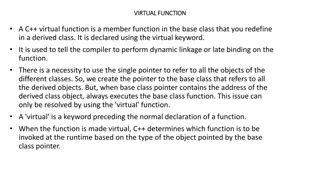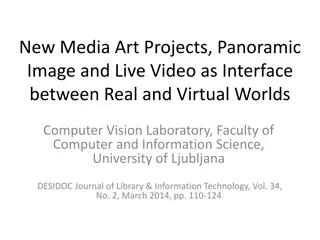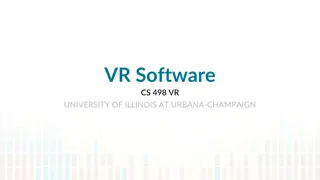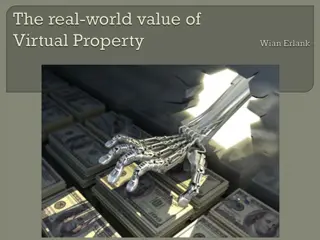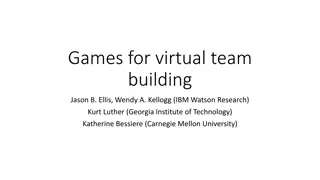Understanding Motion in Real and Virtual Worlds
Explore the impact of physics on virtual reality experiences through mathematical modeling of motion in both real and virtual environments. Learn about tracking methods, human vestibular organs, numerical computations in 1D motion, acceleration, error estimation, Newtonian physics engines, mass and acceleration relationships, and forces like gravity in the context of gaming simulations.
Download Presentation

Please find below an Image/Link to download the presentation.
The content on the website is provided AS IS for your information and personal use only. It may not be sold, licensed, or shared on other websites without obtaining consent from the author. Download presentation by click this link. If you encounter any issues during the download, it is possible that the publisher has removed the file from their server.
E N D
Presentation Transcript
Motion in Real and Virtual Worlds CS 498VR: Virtual Reality UNIVERSITY OF ILLINOIS AT URBANA-CHAMPAIGN Eric Shaffer
Mathematical Modeling of Motion The physics of both real and virtual worlds impact VR experiences. We will look at How phsyics engines model motion in VR How motion tracking methods rely on accelerations and velocities How human vestibular organs rely on accelerations and velocities
1D Motion Suppose y(t) gives a position at a given time How do you compute y(t) if you can measure velocity Numerically we have since
Acceleration Acceleration is the rate of change of the velocity We can approximate this numerically as before
Error Numerically we have We are approximating an integral by stepping in the direction of the velocity This is called Euler Integration Error is proportional to the size of the timestep O( t) which is not good Using a higher order method like 4th order Runge-Kutta (RK4) would be better
A Simple Newtonian Physics Engine We will animate particles (aka point masses) Position is changed by velocity Velocity is changed by acceleration Forces alter acceleration Our physics engine will integrate to compute Position Velocity We set the acceleration by applying forces
Mass and Acceleration To find the acceleration due to a force we have ? is the second derivative of some function ? So we need to know the inverse mass of the particle You can model infinite mass objects by setting this value to 0
Force: Gravity Law of Universal Gravitation f =Gm1m2 r2 G is a universal constant mi is the mass of object I r is the distance between object centers we care only about gravity of the Earth m1 and r are constants r is about 6400 km on Earth We simplify to f = mg g is about 10ms-2 For gaming, 10ms-2 tends to look boring Shooters often use 15ms-2 Driving games often use 20ms-2 Some tune g object-by-object
Force: Gravity If we consider acceleration due to gravity we have So acceleration due to gravity is independent of mass
Force: Drag Drag dampens velocity Caused by friction with the medium the object moves through Even neglecting, you need to dampen velocity Otherwise numerical errors likely drive it higher than it should be A velocity update with drag can be implemented as important to incorporate time so drag changes if the frame rate varies
The Integrator The position update can found using Euler s Method: ????= ????+ ?? Note that is inaccurate, though good enough for simple things Euler s error is O(t) Why is the error worse when acceleration is large? The velocity update is
Collision Detection Often requires use of bounding volumes or spatial data structures 1. Broad Phase: Uses bounding volumes to quickly determine which objects need to be checked closely for collision 2. Narrow Phase: Perform careful, expensive collision checks, such as triangle-triangle intersection for meshes
Bounding Volumes Sphere AABB OOBB Convex Hull Hierarchical (BVH) AABB=Axis Aligned Bounding Box OOBB = Object-Oriented Bounding Box BVH = Bounding Volume Hierarchy
Collision Detection Surprisingly complex topic Even a high-quality engine like Unity has issues We will discuss how to simulate only two types of collision Sphere-Wall Sphere-Sphere We check for a collision when updating position If a collision occurs the velocity vector is altered Position is determined by the contact Position and velocity update are completed with new values over the remaining time
Dynamic Collision Detection Dynamic collision tests an exhibit tunneling if only the final positions of the objects are tested (a) Or even if the paths of the objects are sampled (c) A sweep test assures detection but may not be computationally feasible.
Sphere-Plane Collision Can make it even simpler for the box walls in MP. How?
Collision Resolution First, find closing (aka separating) velocity Component of velocity of two objects in direction from one to another Collisions that preserve momentum are perfectly elastic We will use vs_after = -cvs c is the coefficient of restitution a material property that you choose




